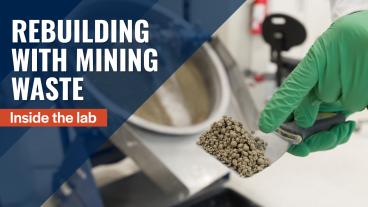 crop .jpg)
Andrew Trautz, who received his master’s degree and PhD in environmental science and engineering from Mines, co-authored the paper, “Role of co-occurring competition and facilitation in plant spacing hydrodynamics in water-limited environments,” with Mines Civil and Environmental Engineering Professor Tissa Illangasekare and Ignacio Rodriguez-Iturbe of Texas A&M University.
The research marks the start of a new focus for the Center for Experimental Study of Subsurface Environmental Processes at Mines, Illangasekare and Trautz said.
“One of biggest challenges issues currently facing humanity today is sufficiently feeding the hungry. Food production will need to increase by over 70 percent by the year 2050 to meet the demands of predicted population growth in the face of the impacts of continued climate change, water scarcity and land degradation which lower agricultural yields,” Trautz said.
“In developed countries such as the U.S., we can meet this challenge through the expansion of arable land, large-scale monoculture farming techniques and heavy reliance on mechanization, over-irrigation and agrochemicals,” he said. “These are not viable options in poor or underdeveloped countries.”
Inspired by natural plant communities in the arid western U.S., researchers utilized CESEP’s wind tunnel-porous media user test facility to study whether plant spacing could be used to control non-consumptive water losses—the water that’s not used by plants but still lost—and therefore improve agricultural yield in regions where water is limited or scarce.
Data generated in the wind tunnel’s controlled environment was used to develop a conceptual model based on established ecological theories to provide insight into how spacing distance can impact plant fecundity, growth, survival and water use. The test facility combines soil tanks ranging in size from centimeters to 7.5 meters with a climate-controlled low-speed wind tunnel.
“We specifically show that there exists a spacing distance range, or ‘Goldilocks zone,’ in which conditions are just right in that non-consumptive water losses are minimized,” Trautz said.
Space the plants too far apart and they can’t rely on their neighbors for support and shelter, impacting bare soil evaporative demand. Space the plants too close together, though, and competition over water in the soil actually leads to increased consumptive water use.
“The reduction of non-consumptive water losses to bare soil evaporation is a ‘low-hanging fruit’ that can help improve agricultural yields,” Trautz said.
CONTACT
Emilie Rusch, Public Information Specialist, Communications and Marketing | 303-273-3361 | erusch@mines.edu
Mark Ramirez, Managing Editor, Communications and Marketing | 303-273-3088 | ramirez@mines.edu



